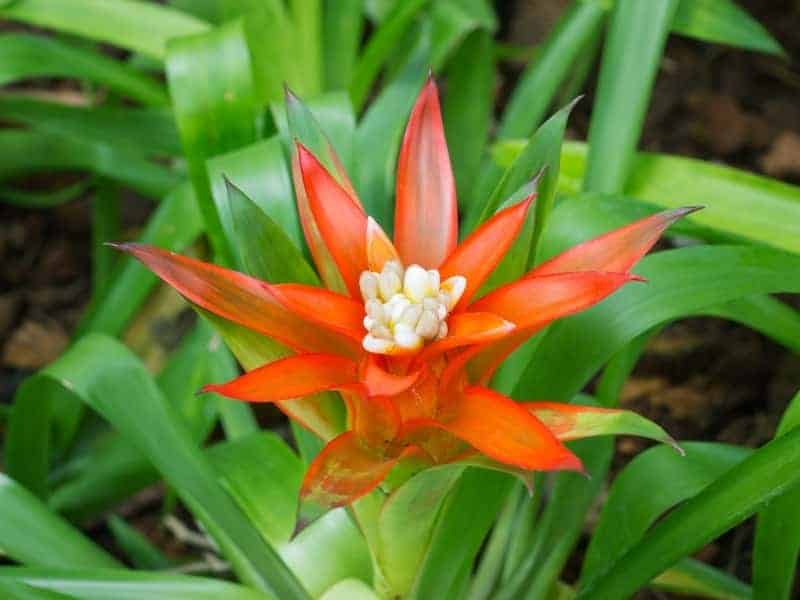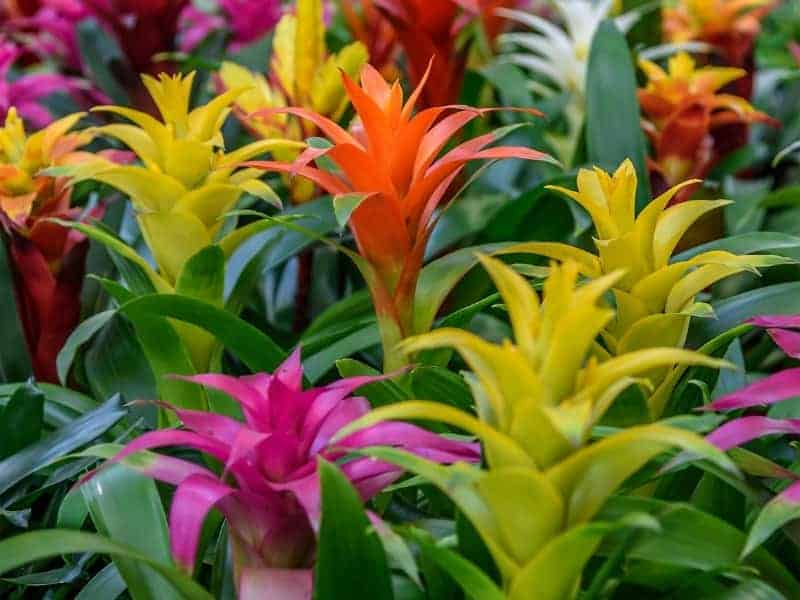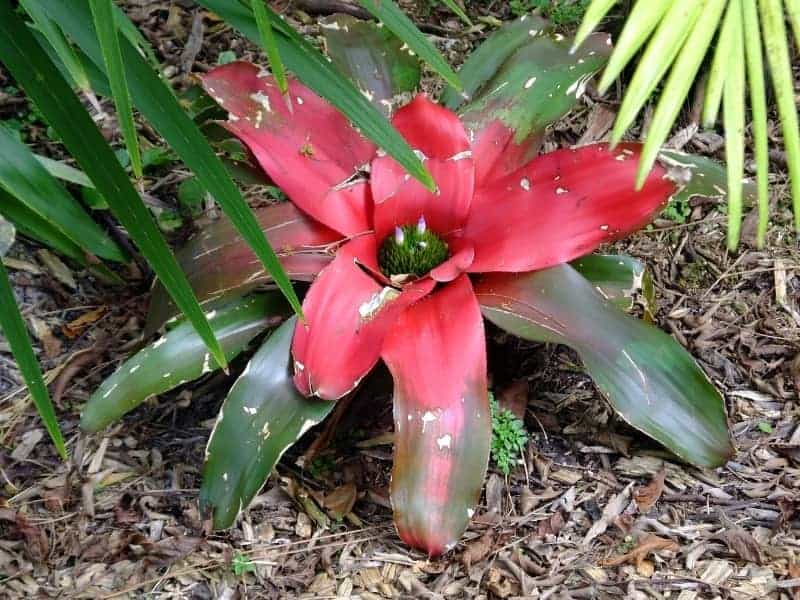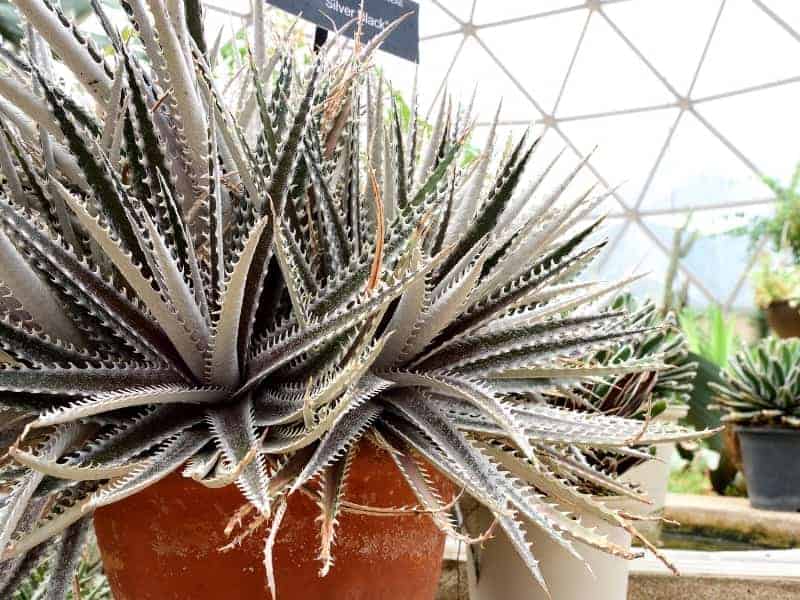What Animals Eat Bromeliads In The Tropical Rainforest
Bromeliads are found in over 2,700 species. The pineapple is among the most well-known bromeliads. Bromeliads are usually orange, red, blueish, or regal and may abound in a multifariousness of ways: terrestrial (on the basis); saxicolous (on rocks); or epiphytic (on other plants and copse).
Bromeliads are indigenous to the Neotropical region. One species, which is believed to have been inadvertently transported into western Africa, is currently thriving there. And so let'southward find out how bromeliads survive in the rainforest.
How exercise bromeliads survive in the rainforest?
Bromeliads are tropical plants that are accustomed to the rainforest ecosystem. Certain bromeliads are vibrant epiphytes that grow on the branches and trunks of rainforest trees and they take an ingenious method of obtaining water and food which allows them to survive in the rainforest.

Bromeliads have adjusted to the tropical rainforest by changing their roots, leaves, and the way they function. Every species on this world when taken to harsh environments either suit or become lost in the mix.
In the instance of the bromeliads they've managed to adapt to the ecosystem and quite frankly they are starting to thrive.
Their dense, wax-like leaves create a cup shape in the center, which serves as a catchment surface area for rainfall. Several liters of water may be held by certain bromeliads, which act as tiny ecosystems in their own correct.
Providing homes for a multifariousness of animals such as frogs and their larvae, salamanders, and their tadpoles, beetles, and mosquito larvae, among others.
Those that perish disintegrate and provide nutrients to the plant in their place. A bromeliad was discovered to be dwelling to numerous tiny beetles, crane flies, earwigs, a frog, spiders, a millipede, a scorpion, fly larvae, woodlice, and an earthworm, amid other creatures
Numerous flora in the Congo pelting forest, such equally the Bromeliads, have evolved to accept aptitude leaves that enable them to absorb water. Bromeliads feature rigid, long leaves that serve as a water conduit, collecting raindrops and supplying nutrients to the plant.
Leaves and other things fall into the Bromeliads' leaf channels, profitable algae and other creatures in their growth, which in turn assists insects and other species in their feeding. Bromeliads act as their habitat since they are dwelling house to creatures such as tree frogs.
Where do bromeliads live?
Bromeliads live in Central and South America, the Caribbean, and West Africa.
They are a kind of orchid. They may be found growing in deserts, mountains, and woodland environments. The pineapple is the about well-known species of bromeliad, still information technology is merely i of more than 3000 singled-out kinds that exist.
The tropical region is home to a diversity of bromeliads. To be even more than precise the bromeliads live in tropical rainforests of Central America namely the Amazon rainforest. This constitute is as well found in the Congo rainforest.
Autonomously from the wild bromeliads with adaptation, they have been introduced as indoor plants most all over the world. So, now they are living in near every continent.
Where practise bromeliads grow in the rainforest?
Bromeliads abound in the canopy layer of the rainforest. The thick leaves and the construction of the bromeliads allow them to position themselves in the rainforest canopy.
The canopy layer contains nearly 90 percent of the overall of all tropical rainforest life. Plants in the canopy layer create a cover of leaves and plant matter that spans the top of the layer.
Considering the emergent layer blocks the majority of light, the canopy layer is densely packed with plants frantically attempting to reach the calorie-free that seeps down, resulting in branches covered with flowers, branches, plants, and other creatures.
Bromeliads are an epiphyte species. They spend their unabridged lives inside the rainforest canopy, never touching the earth with their roots. These waxy, thick-leaved cousins of the pineapple have a bowl shape.
Bromeliads save h2o and frequently provide a habitat for aquatic and semi-aquatic canopy animals such as salamanders, frogs, mosquitoes, snails, mosquito larvae, and beetles.
Where practise bromeliads grow best?
Whether it'due south indoors or outdoors, bromeliads thrive in bright, indirect low-cal. Avoid placing them in an expanse where the afternoon light volition shine directly on their leaves. The direct calorie-free can cause them to burn, but also avoid placing them in a dark corner.
Bromeliads that get bereft light volition develop floppy, long, green leaves that lack their signature color. Simply if you come across the leaves become floppy and lose colour, only move them to the lighted area to increase their exposure to light and the color volition return.
Once nighttime temperatures in your region regularly exceed 60 degrees, it is safe to transfer an indoor bromeliad outside for the summer.
Go along them in a covered, protected location for a few days—this is referred to every bit "hardening off" and will assist the plants in adjusting to their new habitat.
Y'all may and then relocate them farther abroad from the dwelling house after a few days.
Types of bromeliads in the tropical rainforest:
All Bromeliad species are classified asBromelioideae, Tillandsioideae,or Pitcairnioideae. These are the chief three subgroups of the bromeliads.
Tillandsioideae:

Tillandsioideae is a subfamily of the Bromeliaceae bromeliad family. This subfamily includes the most species (i,277).
The majority are epiphytic or lithophytic, growing in trees or on rocks and arresting water and nutrients from the surrounding environment.
Castilian moss is a well-known variant of the Tillandsia genus. Guzmania and Vriesea bromeliads are the well-nigh often grown representatives of this subfamily.
Bromeliaceae:

Bromeliaceae is a flowering plant family (order Poales) with over 3,000 species divided into 56 genera. Except for 1 species, all are indigenous to the tropical New World and West Indies.
The Castilian moss (Tillandsia usneoides) and edible pineapple fruit (Ananas comosus) are the family's primary commercial products.
But the fibrous leaves of certain species (e.m., Aechmea magdalenae and Neoglaziovia Variegata) are used in some areas to make rope, fabric, and netting.
Pitcairnioideae:

This subfamily, which is establish in dry out and high-distance areas, is believed to accept the most ancient ancestry, matching grassy cousins more closely than the exotic novelties represented in the other two subfamilies.
They are constitute in tropical climates where deciduous forests are in abundance.
Why do bromeliads live in the rainforest?
The entirety of the rainforests has such characteristics that make it an ideal place for the bromeliads to alive. Let'due south observe out the details.
Air plants:
Epiphytic bromeliads can absorb nutrients and atmospheric wet, thus they are often referred to as "air plants." Hundreds of these plants may grow on tropical branches, which sometimes cause the branches to fall.
Humidity:
Bromeliads prefer hot and humid weather for their growth. Normally in tropical rainforests temperature ever stays higher up 20 degrees Celsius. Plus the climate stays almost the aforementioned as there are no distinctive seasons in this office of the globe.
Rainfall:
In the tropical rainforests, annually almost 2000 mm of rainfall is recorded over the years. This shows a counterbalanced environs for the bromeliads to thrive in. The water seeps through the canopy and allows the plants to blot and continue their photosynthesis.
Biodiversity:
The diverse ecosystem of the rainforest houses a multitude of flora and fauna. Bromeliads growing on the tree branches have a symbiotic relationship with their surrounding environment.
Why are bromeliads important to the rainforest?
The following reasons made bromeliads important to the rainforest –
Foliage:
All Bromeliads contain trichrome, which are very tiny scales that aid the establish in trapping and absorbing water. While the establish matures, new leaves go on to sprout from the plant's core.
Symbiosis:
Before the stop comes, pups, or young offtips, are formed. These pups feed on the parent plant until they reach the size necessary to develop their roots. They, too, volition somewhen develop and bloom.
Enhances the biodiversity:
Bromeliads have a diverse range of institute types ranging in size from tiny to gigantic. All Bromeliad species are classified as Tillandsioideae, Bromelioideae, or Pitcairnioideae. These subfamilies are further divided into hundreds of genus.
Builds canopy:
Bromeliad roots practice not grow in the earth. Rather than that, they grow on the surface of objects such as trees and rocks and creates a canopy for the rainforest.
Nutrient for animals:
Due to the form of their leaves, the majority of Bromeliads can withstand pregnant rains. Due to the continuous wetness, algae develop in a food chain, forming a tiny self-contained ecosystem.
Tree frogs, worms, snails, and other pocket-sized invertebrates oftentimes spend their whole lives in Bromeliads.
Are bromeliads found in the Amazon rainforest?
Bromeliads tin can be institute in the Amazon rainforest among all the other rainforests located in the tropical region of the earth.
What animals swallow bromeliads in the rainforest?
Arthropod herbivores including tree frogs, snails, worms, and other invertebrates eat leaves, stems, flowers, pollen, and roots. Certain herbivores consume nectar, and some of these and other arthropods pollinate and disperse seeds.
Concluding Thoughts:
To sum information technology up, Bromeliads have adopted in a manner that information technology not simply survives in rainforests, it too thrives. Some bromeliads are vibrant epiphytes growing on rainforest trees' branches and trunks, and they have an ingenious way to become water and food which allows them to survive in the rainforest.
Frequently Asked Questions:
How Long Does a Bromeliad Flower Concluding?
Do Bromeliads Live Later on Flowering? Exercise They Rebloom?
Do Bromeliads Like Humidity?
How Long Tin Bromeliads Live?
Why Do Bromeliads Not Need Soil to Grow?
Source: https://leafyjournal.com/how-do-bromeliads-survive-in-rainforest/
Posted by: hortonsomint1948.blogspot.com

0 Response to "What Animals Eat Bromeliads In The Tropical Rainforest"
Post a Comment